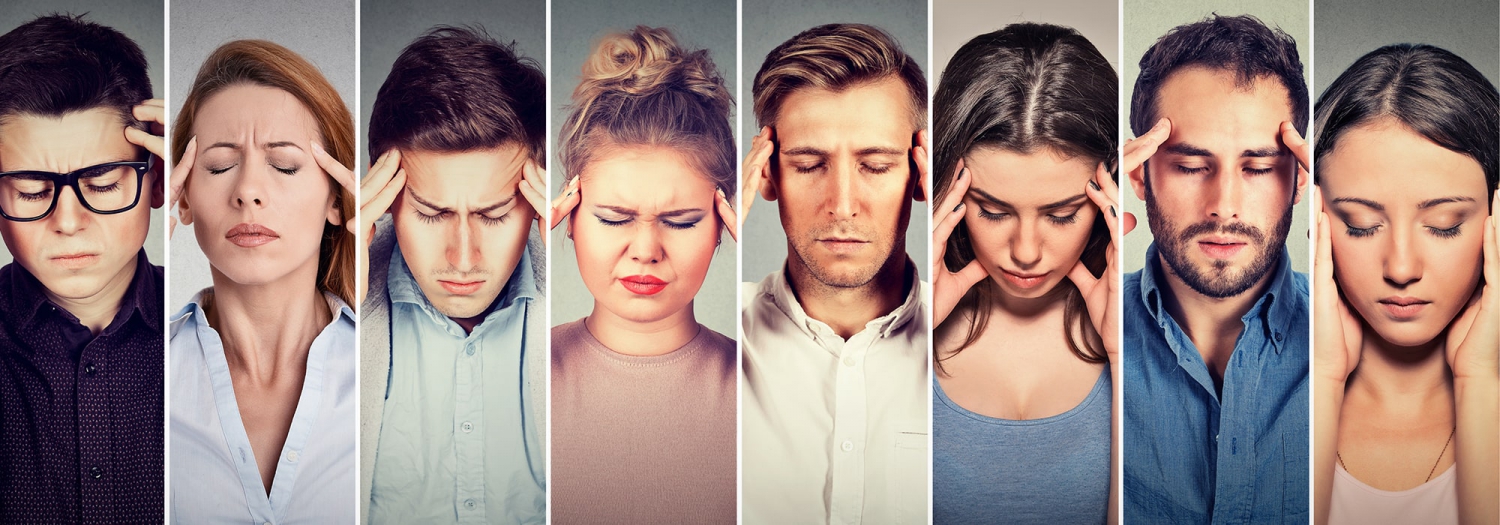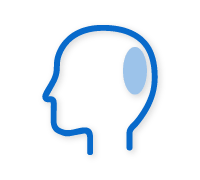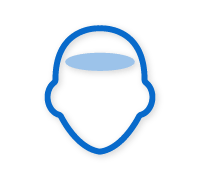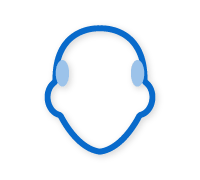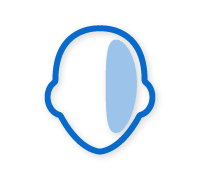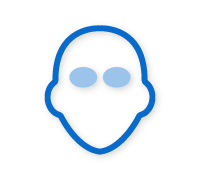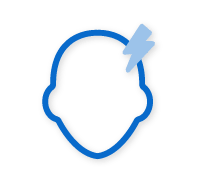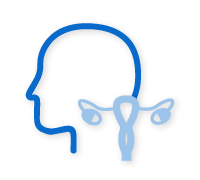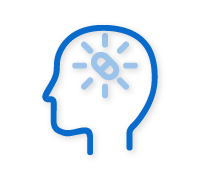Types of migraine - Neuralgia – Headache
Migraines, chronic headaches and neuralgia are not just headaches. They are disabling illnesses in the form of a headache affecting one or both sides of the head.
Migraines take several forms. Firstly, there are migraines with or without aura. The aura is linked to transient neurological disturbances (visual disturbances as in ophthalmic migraines, sensitivity problems, inability to speak) associated with the painful attack. It should be noted that 80% of migraines are without aura.
There are several categories of migraine/headache/neuralgia according to the international classification, such as cluster headache (excruciating pain associated with watery eyes, nasal congestion and facial redness), chronic migraine (pain at least 50% of the time), Arnold’s neuralgia (pain from the nape of the neck due to irritation of the greater occipital nerve or Arnold's nerve), catamenial migraines (headaches during the menstrual cycle). A cluster migraine or facial vascular headache causes attacks several times a day, sometimes only at certain times of the year. Pain frequently develops during sleep, and can last for several hours. 90% of cluster migraine patients are men, most of them aged between 20 and 50. There are also headaches associated with hypertension ("morning headaches"), menstrual headaches, post-traumatic headaches, etc. There are many forms of migraine.
Our group focuses on the main symptoms: pain. We base the best treatment on the location of the pain's starting point and its irradiation.
Pain can be frontal, temporal or occipital.
Frontal migraine
Pain associated with frontal migraines tends to be felt in the afternoon. You may feel pain above the eyebrows, in the inner eye, in the eyebrows corrugator muscle, your eyelid may be drooping, and so on.
When pain radiates to the forehead, it may be due to facial vascular angina, for example. In fact, sometimes vascular angina is part of these frontal migraines.
If the pain starts in the inner corner of the eye, for example.
Facial vascular pain is characterized by a periorbital, temporal and facial irradiation of pain, strictly unilateral, and accompanied by the following symptoms: lacrimation, rhinorrhea, nasal congestion, sweating localized to the face, conjunctival injection, miosis (pupillary constriction).
Temporal migraine
The pain associated with temporal migraine is, in the vast majority of cases, located in the temples and/or the masseter and temporalis muscles (mastication muscles). Pain is most often felt in the morning, and is pulsatile. Patients can usually place a finger on the point that often corresponds to the pulsating artery on the temple.
Let us take the example of facial vascular angina. In fact, it can also be a temporal migraine, particularly if the pain starts at the temples. Vascular angina is typically associated with episodic pain and watery eyes. It occurs in repeated attacks over periods of weeks to months. It is intense, starts abruptly and subsides spontaneously after 15 to 180 minutes, or after taking medication.
Face vascular pain is associated with a strictly unilateral periorbital, temporal and facial localization, and is accompanied by the following symptoms: lacrimation, rhinorrhea, nasal congestion, sweating localized to the face, conjunctival injection, miosis (pupillary constriction).
The appearance of the face is congestive in the painful area, and the eyelid may be edematous. Attacks recur every few hours, up to 48 hours. Several months or years may elapse between attacks.
Occipital neuralgia
Occipital pain is localized to the occipital nerve. This territory, innervated by the occipital nerve, is associated with the nape of the neck, the neck, the temples, or behind the eye. Pain is sometimes associated with, but should not be confused with, aches and pains that occur after “whiplash”. You may also feel pain in your back or neck muscles. There's no specific time of day to feel these pains. Our patients are often in pain all the time (background pain), punctuated by peaks of pain that can be triggered once or several times a week. These episodes may well be linked to physical activity.
Arnold's neuralgia, or neuralgia of the large occipital nerve, affects a nerve in the back of the neck, causing severe head pain. As the name suggests, this condition is caused by irritation of the greater occipital nerve, more commonly known as Arnold’s nerve.
Arnold’s nerve originates between the first and second vertebrae of the neck.
On its way to the skull, it crosses several muscles, including the tendon insertion of the shoulder and neck muscles on the skull, before ending up under the skin. Arnold's nerve can easily become "trapped" and irritated on its way to the skin at the nape of the neck. For this reason, every movement of the head can cause terrible pain and inflammation to the greater occipital nerve or Arnold's nerve.
Arnold’s nerve ends its course in the scalp.
Arnold's neuralgia can be caused by a local muscle contracture, trauma or surgery, or even stress. Unbalanced posture or prolonged sitting at a computer can cause irritation of the occipital or Arnold nerves. There is not always an obvious cause.
Symptoms include unilateral or bilateral pain originating in the hollow between the trapezius and sternocleidomastoid muscles at the nape of the neck, behind the ears, and radiating down the back of the head to the crown and temples. Pain can also extend to the forehead, part of the ear and cause pressure behind or through the eye; scalp hypersensitivity and possibly burning.
In our clinic, we systematically question each and every one of our patients. We rule out any other disease. The theory behind the surgery is that some migraines/headaches/neuralgias are caused when sensitive nerve branches become trapped and irritated. Cortisone infiltrations can temporarily reduce inflammation in the passageway of the greater occipital nerve or Arnold's nerve at the nape of the neck. Botox or botulinum toxin injections can relax neck muscles, relieving Arnold’s neuralgia pain for 2-3 months.
All our treatments target the symptoms of migraine/headache/neuralgia rather than the migraine itself.
Prices
| Consultation with full headache assessment and neurological examination of the head | CHF 350 |
| Consultation with full headache assessment and neurological head examination, plus diagnostic and therapeutic infiltration tests | CHF 450 to 600 |
| Remote consultation (telephone or videoconference) and complete headache assessment | CHF 200 to 250 |
| Diagnostic and therapeutic infiltration test | CHF 350 to 600 |
| Written medical report at patient’s request | CHF 150 |
Avenue Jomini 8
1004 Lausanne
Suisse
+41 (0)21 653 29 21
Mon9h-12h 14h-18h
Tue9h-12h 14h-18h
Wed9h-12h 14h-18h
Thu9h-12h 14h-18h
Fri9h-12h 14h-18h


